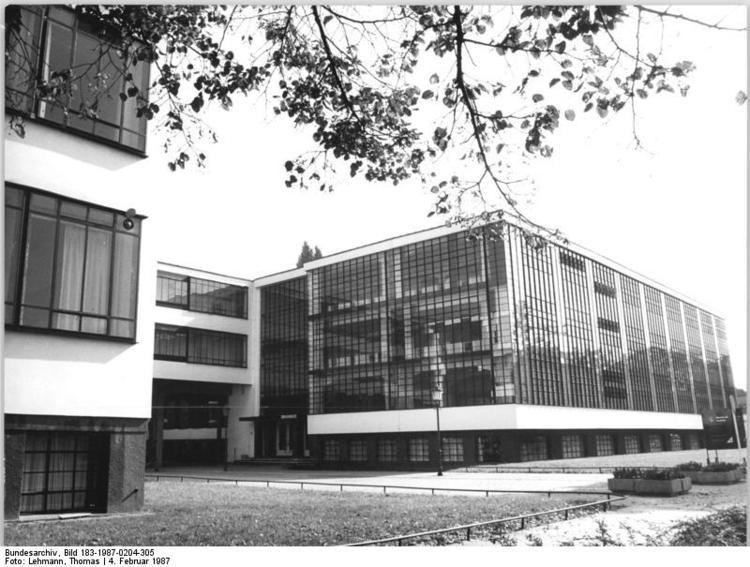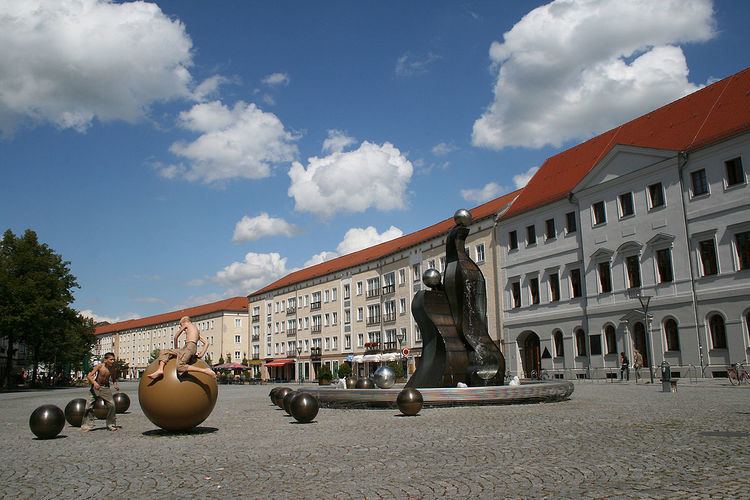Country Germany Area 182.81 km2 | ||
 | ||
District Urban districts of Germany | ||
Map of Dessau
Dessau is a town and former municipality in Germany on the junction of the rivers Mulde and Elbe, in the Bundesland (Federal State) of Saxony-Anhalt. Since 1 July 2007, it has been part of the newly created municipality of Dessau-Roßlau. Population of Dessau proper: 77,973 (June 2006).
Contents
- Map of Dessau
- Walter gropius the dessau bauhaus
- Geography
- History
- Castles and gardens
- The Bauhaus
- Churches
- Other sights
- Theatres and museums
- Regional media
- Public transport
- Railway stations
- Roads
- The airfield
- Water
- Bikes
- Sports
- Facilities
- Governance
- Mayor
- Town Council Stadtrat
- Town twinning
- Education
- European subsidies
- Notable people
- Born in Dessau before 1900
- After 1900 born in Dessau
- References

Walter gropius the dessau bauhaus
Geography

Dessau is situated on a floodplain where the Mulde flows into the Elbe. This causes yearly floods. The worst flood took place in the year 2002, when the Waldersee district was nearly completely flooded. The south of Dessau touches a well-wooded area called Mosigkauer Heide. The highest elevation is a 110 m high former rubbish dump called Scherbelberg in the southwest of Dessau. Dessau is surrounded by numerous parks and palaces that ranks Dessau as one of the greenest towns in Germany.
History

Dessau was first mentioned in 1213. It became an important centre in 1570, when the Principality of Anhalt was founded. Dessau became the capital of this state within the Holy Roman Empire. In 1603 the state was split into four – later five – Anhalts, Dessau becoming the capital of the mini-state of Anhalt-Dessau. In 1863 two of the noble lines died out, and the Duchy of Anhalt became reunited. From 1918 to 1945, Dessau was the capital of Free State of Anhalt.
Dessau is famous for its college of architecture Bauhaus. It moved here in 1925 after it had been forced to close in Weimar. Many famous artists were lecturers in Dessau in the following years, among them Walter Gropius, Paul Klee and Wassily Kandinsky. The Nazis forced the closure of the Bauhaus in 1931, and it was not reopened until 1986.
The town was almost completely destroyed by Allied air raids in World War II on 7 March 1945, six weeks before American troops occupied the town. Afterwards it was rebuilt with typical GDR concrete slab architecture (Plattenbau) and became a major industrial centre of East Germany. Since German reunification in 1990 many historic buildings have been restored.
The composer Kurt Weill was born in Dessau. Since 1993 the city has hosted an annual Kurt Weill Festival. Dessau was also the birthplace of the philosopher Moses Mendelssohn (in 1729), and Leopold I, Prince of Anhalt-Dessau (der alte Dessauer) (on 3 July 1676), a lauded field marshal for the Kingdom of Prussia.
In January 2005, Dessau gained notoriety for the mysterious death of a Sierra Leonean convicted drug trafficker and failed asylum seeker Oury Jalloh in his cell at a Dessau police station. According to local police, Jalloh, who was drunk and had been tied to his bed because he was volatile and violent, set his own mattress on fire, causing his own death as he burned alive. A number of contradictions and inconsistencies as well as the disappearance of key evidence such as video tapes have led to allegations that the police and maybe even the local court may have been involved in Jalloh's death and subsequent cover-up efforts. A local court acquitted officers in 2008. In 2010, however, a higher federal court declared the ruling null and void, and ordered a new investigation and trial be launched.
Castles and gardens
The Bauhaus
There are several examples of Bauhaus architecture in Dessau, some of them included in the UNESCO World Heritage. The Bauhaus college itself was constructed based on designs by Walter Adolph Georg Gropius.
Churches
Other sights
Theatres and museums
Regional media
Public transport
The Dessau tramway network has three lines and is supplemented by numerous bus lines. Dessau's public transport is operated by Dessauer Verkehrsgesellschaft (DVG), which transports around 6 million people each year.
Railway stations
Dessau Hauptbahnhof (main station) has connections to Magdeburg, Berlin, Leipzig, Halle, Bitterfeld and Lutherstadt Wittenberg. The line from Berlin was opened on 1 September 1840. The Dessau-Bitterfeld line (opened on 17 August 1857) was electrified in 1911, the first fully electrified long-distance railway in Germany. Dessau was part of the InterCity long distance network until the year 2002. Regional trains also stop at the stations Dessau-Süd, Dessau-Alten, Dessau-Mosigkau and Rodleben. The Dessau-Wörlitzer-Eisenbahn (railway) connects Dessau to Wörlitz, a town situated 15 km to the east, and the Wörlitzer Park. Starting point of this railway is the main station. This train also stops at the stations Dessau-Waldersee and Dessau-Adria.
Roads
In 1938 the autobahn A9 (Munich-Berlin) was built southeast of the town area. The two exits to Dessau on the A9 are called "Dessau-Ost" and "Dessau-Süd". Dessau is also crossed by the "Bundesstrassen" (federal roads) B 184 and B 185.
The airfield
The airfield of Dessau is situated northwest of the town between the districts Kleinkühnau, Alten and Siedlung. A destination with a charter airplane is possible. The runway has a length of 1000 m. The Hugo Junkers Technical Museum is situated in the neighbourhood (directly east) of the airfield, which has the eastern end of the modern runway almost directly abutting the historical World War II Junkers factory airstrip's western end.
Water
Today the "Leopoldshafen" (harbour) is used for the annual international motorboat racing events. The "Wallwitzhafen" is used as a private sportboat harbour and the "Elbehafen" near the Grain House is used for cruisers. The next harbour for goods is situated in Rosslau.
Bikes
Dessau, is located in the flat landscape of the Saxon Lowland. The bike roads have a length of about 146 km and connect all the parks and sights.
Sports
Sports like soccer, cycling, handball, volleyball, gymnastics, table tennis and tennis have a long tradition and are very popular in Dessau. The former soccer team "SG Waggonbau Dessau" won the GDR soccer cup in 1949. The handball team played in the GDR "Oberliga" and since 1990 they are playing in the 1st and 2nd "Bundesliga". Currently, Dessau has around 80 sport clubs with over 13,500 members. Next to the traditional sports, Dessau has active sport clubs in the following disciplines: aikido, badminton, basketball, canoeing, chess, climbing, cycling, dancing, fishing, horse riding, karate, judo, jiu-jitsu, motorboat, rowing, speedskating, sailing, skittles, skydiving, squash, swimming, table tennis, water polo, wrestling and others.
Facilities
Governance
The borough of Dessau is mentioned first in 1372. The Head of the Town called "Schultheiss" was constituted by the Earl. Together with a few assessors the "Schultheiss" formed the Town Council. As of 1372 the Town Council was divided in 2 agencies. As of 1600 in three agencies and as of 1785 again in two agencies. The "Schultheiss" of Dessau changed nearly every year until the Town Council Constitution was cancelled in 1832. Afterwards Dessau became a Town Council and a Town Delegation Constitution. Since 1852 the Head of the Town is called Mayor. During the National Socialist period the Mayor was constituted by the party (NSDAP). After World War II the Soviets formed an Executive Council with a Mayor. The Town Council Constitution was elected by the people. Since the German reunification this committee is elected free. And since 1994 it's called "Stadtrat" (Town Council). The Mayor has been directly elected by the people since 1994.
Mayor
Peter Kuras (born 1958) was elected mayor in June 2014 with 75,82 % of the votes for a term of seven years. He is the successor of Klemens Koschig (born 1957, independent), who was elected in 2007 with 56,8 % of the votes.
Town Council (Stadtrat)
Consists of the following parties: (Local Elections from 25 May 2014)
Town twinning
Education
European subsidies
Dessau is part of the EU-URBAN programme. This programme is based on the integrated approach that is used for tackling the environmental, economical and social problems, affecting the deprived urban areas. There are several projects in Dessau sponsored via this subsidy.
